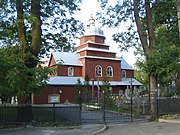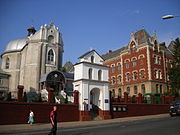Drohobych
| Drohobych | ||
| Дрогобич | ||

|
|
|
| Basic data | ||
|---|---|---|
| Oblast : | Lviv Oblast | |
| Rajon : | District-free city | |
| Height : | 297 m | |
| Area : | 44.5 km² | |
| Residents : | 76,375 (2018) | |
| Population density : | 1,716 inhabitants per km² | |
| Postcodes : | 82100 | |
| Area code : | +380 3244 | |
| Geographic location : | 49 ° 21 ' N , 23 ° 30' E | |
| KOATUU : | 4610600000 | |
| Administrative structure : | 2 cities | |
| Mayor : | Taras Kuchma | |
| Address: | пл. Ринок 1 82100 м. Дрогобич |
|
| Website : | Drohobych City Council | |
| Statistical information | ||
|
|
||
Drohobych ( Ukrainian Дрогобич ; Russian Дрогобыч Drogobytsch , Polish Drohobycz ; Yiddish דראָביטש) is a Ukrainian city with 76,300 inhabitants (2018). It is located in the Lviv Oblast , south of the district capital Lviv , which is also the next larger city.
The town of Stebnyk still belongs to the municipality , Drohobytsch is the center of the district of the Drohobych district of the same name , but is not itself part of it, but the urban area is completely enclosed by it.
History of the city
Drohobych was founded in the late 11th century . The city became famous for its salt mines . It was a center of salt production as early as the 14th century . From 1340 to 1772 the city was part of the Ziemia Przemyska (Polish: Przemyśler Land) in the Kingdom of Poland , from 1569 to 1772 it was part of the Ruthenia Voivodeship , an administrative unit of the aristocratic republic of Poland-Lithuania . Between 1939 and 1959, Drohobych was the capital of the 10,400 km² Drohobych Oblast with over 850,000 inhabitants.

Austrian crown land
After the first division of Poland , Drohobytsch was part of the Austrian Crown Land of Galicia and Lodomeria from 1772 to 1918 . In the 18th century a school of the Ukrainian Brotherhood was founded and later a high school . Since 1896 the school has been housed in a building that is now the main building of the Pedagogical Institute. This school was attended by the young Ivan Franko , who was born in a nearby village. At the end of the 19th century , oil was found near the city . A boom then set in. In 1880 there were already 36 oil companies in Drohobych. The population grew rapidly, everyone hoped for work and a modest livelihood. But living conditions were harsh and the region was nicknamed "Galician Hell". From an administrative point of view, the place was the seat of the district administration of the Drohobycz district from 1850 , in 1867 a district court was added, both of which existed until 1918.
Changing affiliation
From 1919 to 1939 the city belonged to Poland and was from 1921 in the Lviv Voivodeship . Before the Second World War , Drohobych had about 35,000 inhabitants, including 35 percent Poles and 20 percent Ukrainians . Many of the residents were Jews who made their living as workers in the oil wells, as there are large oil and natural gas deposits in this area. There are also large potash deposits. The Drohobych Great Synagogue was the largest synagogue in Poland at that time, even larger than that of Warsaw. In 1939 the Red Army occupied the city as agreed in the secret additional protocol of the German-Soviet non-aggression pact . In 1941 the German Wehrmacht took Drohobych during the attack on the Soviet Union . When the ghetto was dissolved, the Jews were deported to extermination camps in 1943. On August 6, 1944, the Red Army occupied the city again.
In 1945 the city and eastern Poland became part of the Soviet Union and became part of the Ukrainian SSR . The Polish population was expelled .
Persecution of Jews (1941–1944)
Before the Second World War, around 15,000 people - around 40% of the city's population - belonged to the Jewish community. Immediately after the Wehrmacht marched in on June 30, 1941, Ukrainians murdered more than 300 Jews in a three-day pogrom with the support of members of the Wehrmacht. Arbitrary arrests followed, forced labor and identification with a white ribbon with a Star of David. Walter Kutschmann headed the Gestapo office in Drohobytsch until March 1942 . At the end of March 1942, 2,000 Jews were deported to the Belzec extermination camp . Selections were carried out between August 8 and 17, 1942: In the course of this action, over 600 Jews were killed by Ukrainian auxiliary police and the SS in the streets and squares and 2,500 were deported to Belzec. At the beginning of October 1942, the Drohobych ghetto was established with 10,000 Jews, including survivors from local Jewish communities. In further "actions" in October and November 1942, more than 3,300 Jews were sent to the Belzec extermination camp and on February 15, 1943, 450 ghetto inmates were shot in the forest of Broniza. Between May 21, 1943 and June 20, the ghetto was dissolved and, with few exceptions, the Jews from the oil industry's labor camps were also murdered. After the liberation, only 400 survivors were recorded.
Buildings
- Orthodox Church of St. George, around 1500, part of the World Heritage Wooden Churches of the Carpathian Region
- Former Catholic Castle Church of St. Bartholomew, 1392–16. century
- Orthodox Church of the Assumption, late 15th century
- Holy Cross Orthodox Church, early 16th century
- Choral Synagogue , 1842–1865
- Ose Chesed Synagogue (in Stryjska Ulitsa)
- Town hall, 1920s, neoclassical
Basilian monastery of St. Peter and Paul, 1825–1828
Town twinning
-
 Buffalo , United States
Buffalo , United States -
 Legnica , Poland
Legnica , Poland -
 Olecko , Poland
Olecko , Poland -
 Ostrzeszów , Poland
Ostrzeszów , Poland -
 Dęblin , Poland
Dęblin , Poland
Personalities
- Jurij Drohobytsch (1450–1494), Red Ruthenian astronomer, astrologer, physician and philosopher
- Wilhelm Leopolski (1828–1892), Austrian-Polish history and portrait painter of realism
- Maurycy Gottlieb (1856–1879), Polish painter
- Ivan Franko (1856–1916), Ukrainian poet and writer
- Leon Sternbach (1864–1940), Polish university professor and victim of the Holocaust
- Herman Lieberman (1870–1941), Polish politician
- Jonas Kreppel (1874–1940), Austrian writer and publicist
- Ephraim Moses Lilien (1874–1925), German Jewish painter
- Léopold Gottlieb (1879–1934), Polish painter
- Norbert Liebermann (1881–1959), Austrian insurance specialist and general director of Wiener Städtische Versicherungsanstalt
- Kajetan Stefanowicz (1886–1920), Polish Art Nouveau painter
- Bruno Schulz (1892–1942), Polish writer and painter
- Kazimierz Wierzyński (1894–1969), Polish writer
- Joachim Weingart (1895–1942), Polish painter
- Joseph Wilder (1895–1976), Austrian-American neurologist and psychiatrist
- Isaak Hallemann (1896–1942), educator and director of the Jewish orphanage in Fürth, Bavaria
- Elisabeth Bergner (1897–1986), Austro-English actress
- David Horovitz (1899–1979), Israeli economist, first governor of the Israel Bank
- Shin Shalom (Shalom Yossef Shapira) (1905–1990), Israeli Hebrew poet
- Mordecai Roshwald (1921–2015), American social scientist and writer
- Alfred Schreyer (1922–2015), Polish opera singer and musician
- Adam Zielinski (1929-2010), Polish-Austrian writer
- Wiktor Wekselberg (* 1957), Russian oligarch
- Ihor Palij (born 1963), artist
- Volodymyr Bileka (* 1979), racing cyclist
- Yaroslav Popovych (* 1980), racing cyclist
See also
Web links
- Homepage about the city in English.
- Drohobyczer newspaper in Ukrainian
Individual evidence
- ↑ Cities and Settlements in Ukraine on pop-stat.mashke.org ; accessed on December 29, 2018
- ↑ General Reich Law and Government Gazette for the Empire of Austria of October 8, 1850, No. 383, page 1741
- ↑ Only for a few experts did this offer a chance of survival, cf. Christian Gerlach: Calculated Murders - The German Economic and Extermination Policy in Belarus 1941 to 1944 . Study edition Hamburg 2000, ISBN 3-930908-63-8 , pp. 529 + 576.
- ↑ so at Gutmann, but see also documents VEJ 7/21 and VEJ 7/46.
- ↑ a b Israel Gutman u. a. (Ed.): Encyclopedia of the Holocaust . Munich and Zurich 1995, ISBN 3-492-22700-7 , vol. 1, p. 371.
- ^ Israel Gutman et al. a. (Ed.): Encyclopedia of the Holocaust . Munich and Zurich 1995, ISBN 3-492-22700-7 , Vol. 1, pp. 371/372.










